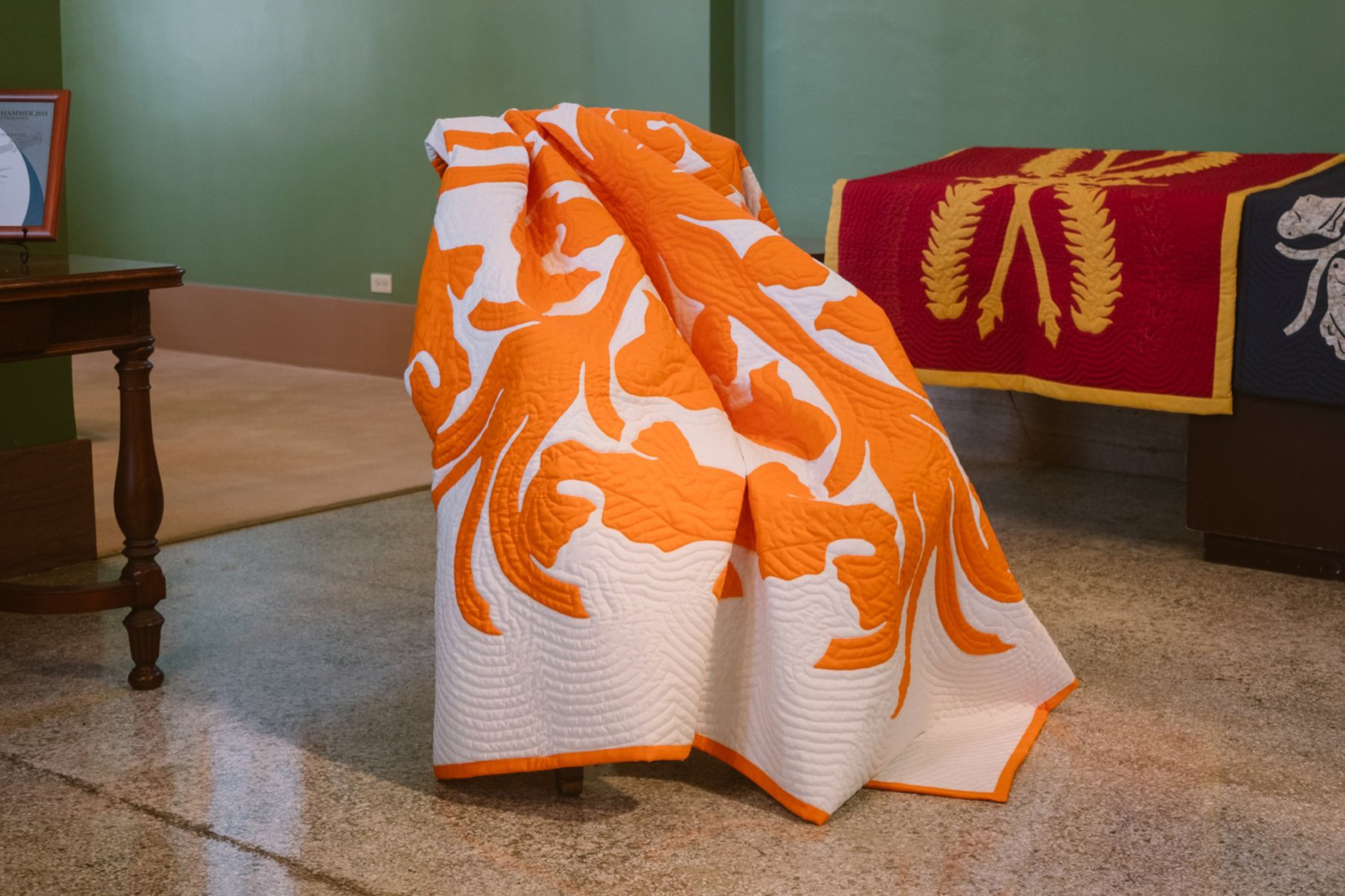The latest instances by American designers appropriating the distinctly local artform of Hawaiian quilting begs the question: Is there a pono way for a fashion brand to utilize its patterns?
Locals could spot the pattern from a mile away. With its distinctly rotund center and yawning leaves, it could only have been ‘ulu, or breadfruit, a staple flora in the Hawaiian islands for centuries. The way it was silhouetted, similar to a paper snowflake cut on a four- or eight-fold bias, then placed in a repeating manner, could only have been appliqué, a technique central to Hawaiian quilting. In almost any other setting, like within a neighbor’s home on quilted pillowcases, or in tūtū’s closet adorning her mu‘umu‘u, it wouldn’t have mattered much. But in this instance, something was pilau.
Although the design was clearly Hawaiian, the designer was definitely not: It was REDValentino, the lower-priced, contemporary, ready-to-wear brand of the Italian fashion house Valentino.
The offending garment—a black-and-white cotton poplin pleated dress covered in a “Flower Damier print” according to the product copy—reeked of cultural appropriation to many Hawai‘i locals, particularly Native Hawaiians.
And they let REDValentino know it on Instagram, where the brand had posted a campaign image of the dress in February 2021.
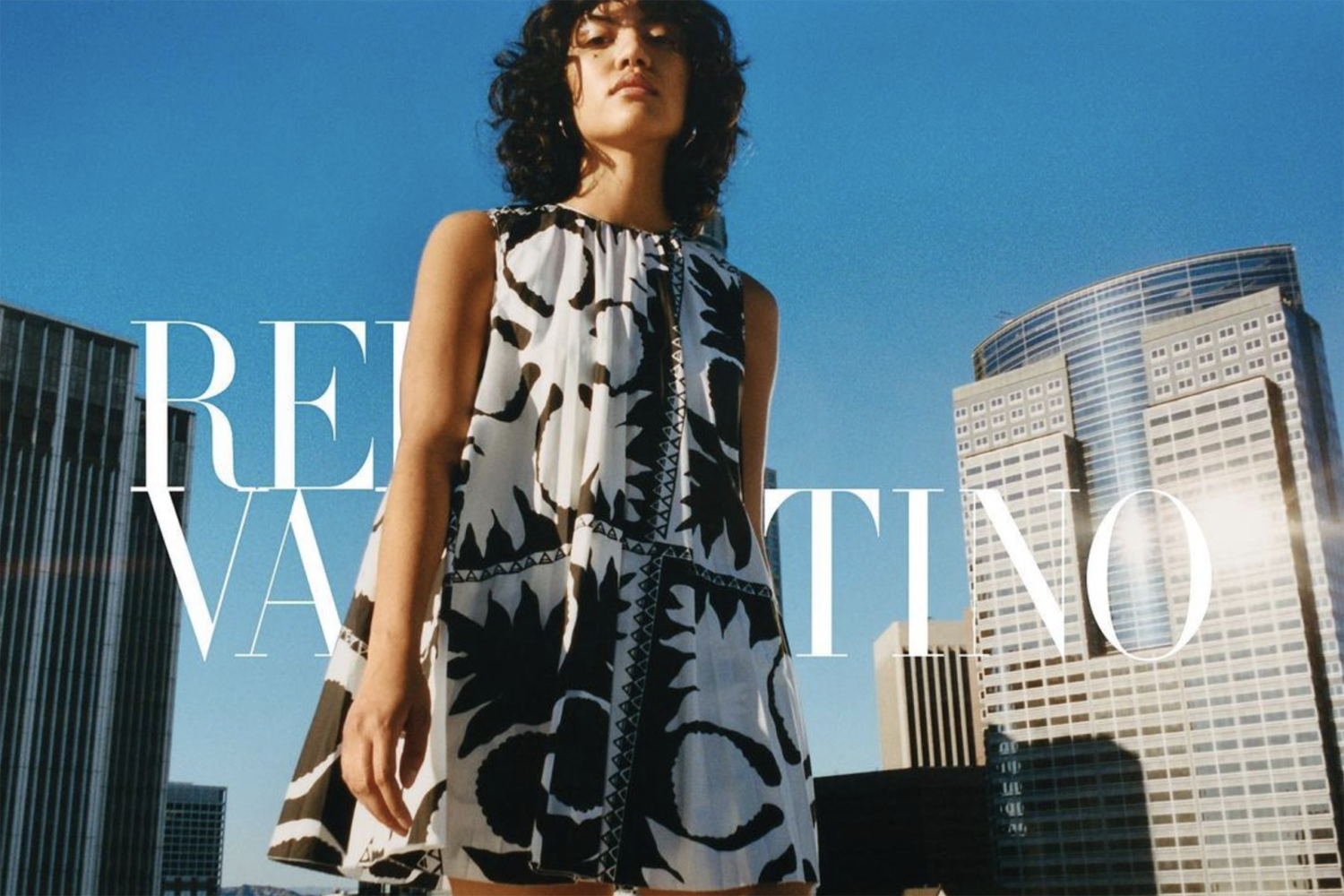

“Auē,” wrote @aariyoo.
“1195 dollars for a dress of STOLEN designs,” pointed out @ipolani.mae.
“This is definitely a Hawaiian design, nothing new here, except for maybe a colonizer taking what isn’t theirs,” expressed @cheyennekanani.
Many tagged @diet_prada, the fashion account that’s become a clarion call of corrective criticism—or cancel culture, depending on your perspective— and used hashtags like #culturevulture. The brand stayed mum. Four days later, they posted another campaign image. More comments arrived.
“A‘OLE,” said @_jkahue.
“Shame on you for stealing from Hawaiian culture and trying to profit off it,” criticized @mikala.designs.
“This print is obviously taken from Kapa Kuiki (Hawaiian Quilt) ‘Ulu (breadfruit). Calling it “flower” print doesn’t make it your own. Will you be giving credit to Hawaiians for their art?” @ajamaile asked.
A full month later, on March 23, REDValentino issued an apology on Instagram, accounting for its mistake. It recognized the Hawaiian art form of kapa kuiki, its improper use of the print, and lack of research. It acknowledged the harm done and committed “to working with local Hawaiian organizations to identify opportunities to further support the community.”


Though never publicly announced, it pulled the garments in question from its e-commerce site. In the background, REDValentino reached out to the Office of Hawaiian Affairs, the semi-autonomous state agency responsible for improving the wellbeing of all Native Hawaiians. OHA connected the company with Vicky Holt Takamine, a kumu hula and the executive director of Pa‘i Foundation.
Together, Holt Takamine and REDValentino selected three Kanaka Maoli designers— Kēhaulani Nielson of Kahulaleʻa; Manaola Yap of Manaola; and Kini Zamora—to show original prints on REDValentino clothing at London’s annual floral art show, Chelsea in Bloom, in September 2021. It was a rare instance of cultural appropriation gone right; one that might have never happened without social media.
While many commenters contributed to that success, only a handful recognized that the print belonged to a specific Hawaiian fashion designer and artist, Allen Akina, who was prominent in the 1970s, ’80s, and ’90s.
“We could be mad about cultural appropriation, but due credit wasn’t being given to the person who created that print and those fabrics,” said Paige Okamura, a radio host on Hawaii Public Radio, by phone in August 2021. Okamura, whose mother worked for Akina in her twenties, created an Instagram Story of Akina’s work, pointing out that his pattern was being used on the clothing.
It was a rare instance of cultural appropriation gone right; one that might have never happened without social media.
The whole debacle brought up important questions: Is calling out appropriation enough if the original owner isn’t ultimately attributed? And what could the recent resurgence of the Hawaiian quilt, even if through cultural appropriation, mean for the art form’s future?
If part of rectifying cultural appropriation requires “giving credit where credit is due,” as many critics demanded, then understanding the history of the Hawaiian quilt—and how every designers’ specific pattern is intrinsic to the art—is a fundamental place to start.
Although now taught by a community of tūtū and aunties, quilting came to the islands by way of Protestant missionaries. Along with their bibles and beliefs, they carried their quilts across the Pacific in the 1820s. The large, bold, and sentimental textiles were done in one of two styles: either patchwork (small pieces of geometric fabric pieced together into a vibrant tapestry) or album (numerous blocks appliquéd with meaningful designs).
Woven fabric was new to Hawai‘i then. Hawaiians still used kapa, a cloth made from the stripped inner bark of paper mulberry trees that was pounded into paper-thin sheets. Occasionally this cloth was stitched together using twine into a blanket called kapa moe.
The earliest iterations of Hawaiian quilts featured red or indigo freehand or snowflake designs that were cut from colored kapa and pounded into the kapa moe. Hawaiian women created this pinkish kapa by deconstructing colored woven fabric they traded from missionary women, which they then pounded (using a technique called pau‘i‘ula, meaning “to beat in red”) into kapa fibers.
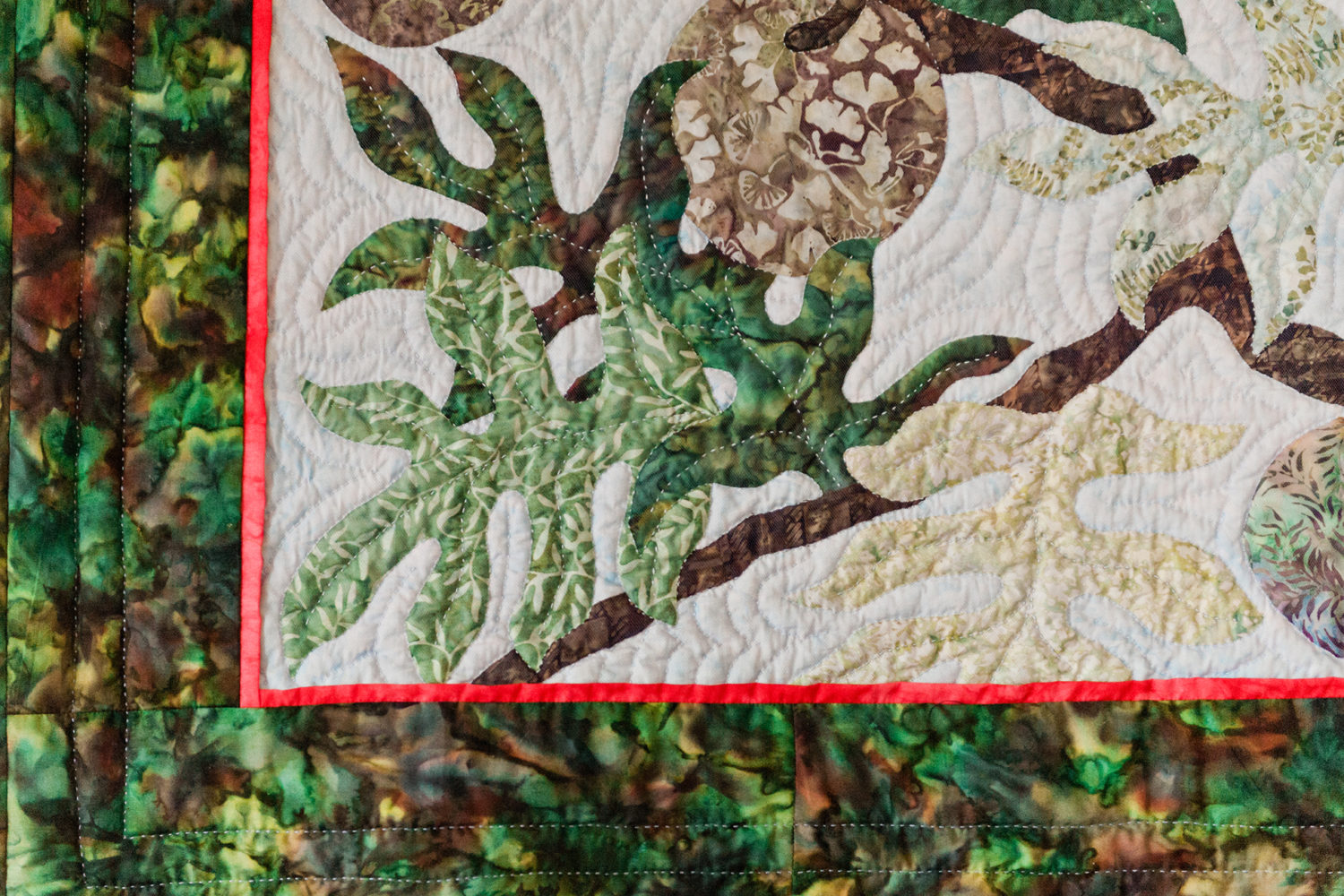

Around the 1830s, missionary women taught Hawaiians how to sew. “They said, ‘We came here to save souls, not to be seamstresses,’” explained Linda B. Arthur, author of The Hawaiian Quilt: A Unique American Art Form, by phone. “They got really tired of the Queens expecting them to do all their sewing for them.” Stitchery was taught in missionary schools, and Hawaiian women learned patchwork quilting (called “kapa pohopoho”) first.
One of the earliest kapa pohopoho quilts was made by Princess Bernice Pauahi between 1839 and 1843, but the style never really stuck.
Instead, Hawaiian women slowly adapted traditional appliqué quilt patterns, eventually enlarging them to the substantial size that’s so distinctive today. (One longstanding story about the origins of the Hawaiian quilt claims that a local woman was drawing her sheets out to dry when a shadow from a nearby tree shaded it, inspiring her to make a quilt pattern.)
The artistry gave Hawaiian women autonomy during a time of rapid westernization in the 19th century. As Arthur wrote in The Hawaiian Quilt, “Hawaiians had lost their religion, their language, and traditions, but retained artistic expression in the quilts.”
Today, Hawaiian quilting is defined by a bright piece of cloth featuring a pattern, typically an all-over floral, that is cut on a quarter- or eighth-inch bias and handstitched to a white backing with kukui lau, or echo quilting. (Kukui lau is a contouring style that uses small stitches to outline the motif in rows that radiate outward, “like waves in the ocean,” Arthur wrote.) The first clearly dated Hawaiian quilt to follow this style was made for Prince Albert’s birth in 1858, with four diaper pins incorporated into its center design; it currently lives at Queen Emma’s Summer Palace.
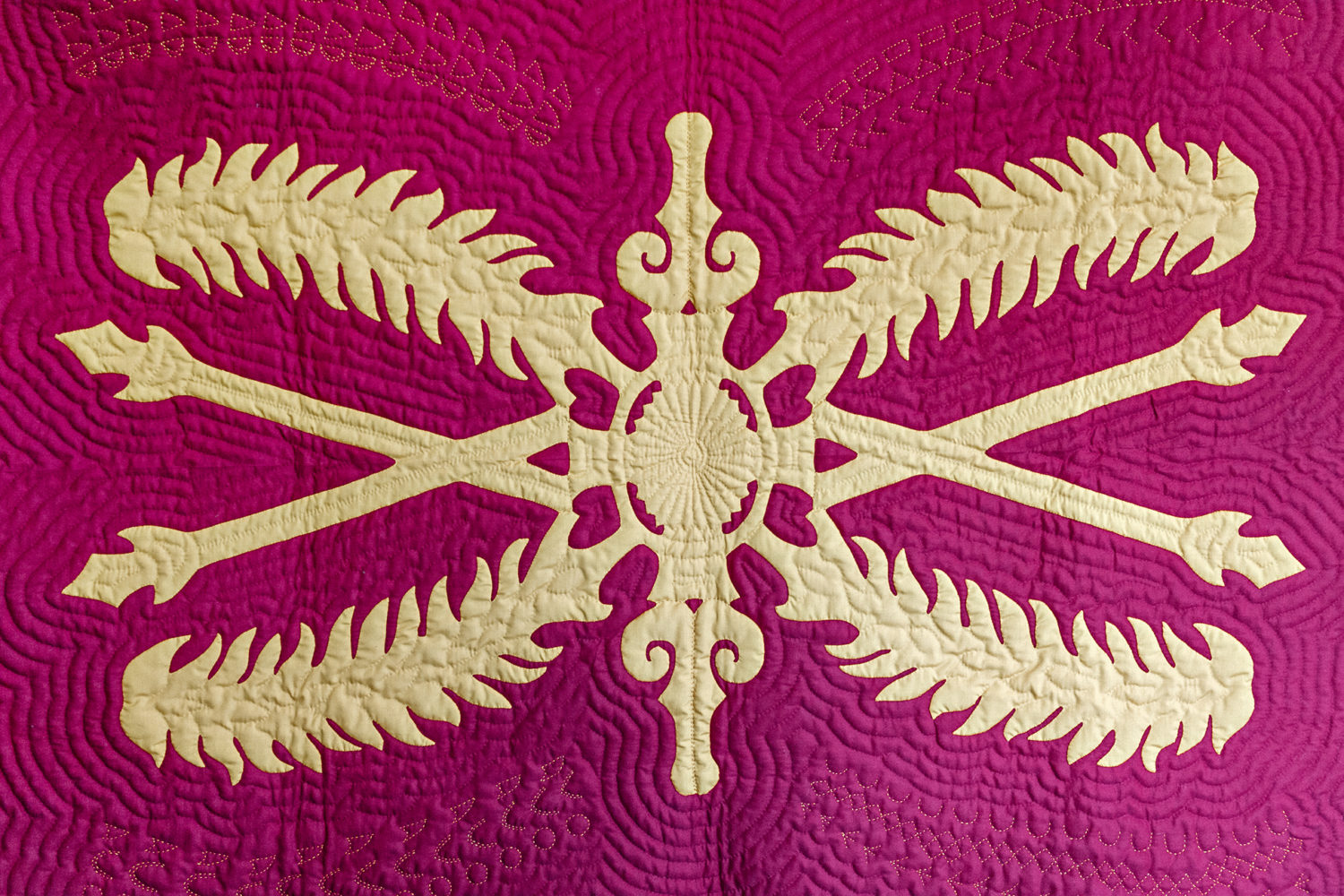

“Because of the kapa-making tradition where individuals have their own patterns, people developed their own ones in different areas of different islands,” explained Tory Laitila, Honolulu Museum of Art’s curator of textiles and historic arts of Hawai’i, by phone.
“According to tradition, somebody gave you, or allowed you to copy, a pattern before making it.” Patterns were beholden to kapu, or ancient codes of law. Black fabric was kapu. So were representations of living things. People looked to local flowers and plants for inspiration—including ‘ulu, which continues to be the first pattern novice quilters learn both for its simplicity and significance. “It’s not just the technique of sewing it [that you learn], but the symbols of the pattern,” said Laitila. “By sewing this plant, it will grow, foster, and nurture you— and that helps the skill or the craftsmanship of making quilts to grow.”
Inherent to every pattern is deep symbolism, and some were so private that only the quilter would know. (One such pattern Arthur referenced in her book was “Press Gently,” which “when kept on the marital bed, was intended to remind the new husband to be gentle when making love.”)
Quilts were presented at significant events like births and weddings; they were passed down between families for generations. Later, with statehood, kapu went kaput and the era of the contemporary Hawaiian quilt arrived. Hawaiian flags advocating for sovereignty became more prominent, and more patterns incorporated living beings.
The aesthetic became eclectic: Numerous kinds of fabrics and colors (versus the traditional white background with one colored pattern) were incorporated, and machine embroidery and appliqué (versus hand stitching) became de rigeur.
What fashion houses like REDValentino and Sea New York failed to grasp was both the deep symbolic meaning of patterns and the spiritual significance of quilting.
By the 1970s, quilting patterns migrated from bedspreads to aloha wear. They reached a fever pitch in the ’80s.
Local designers like Barbara Maldonado placed quilt appliqués on chambray shirts. Puamana Crabbe stitch-quilted Hawaiian florals on her shirts. Mamo Howell colorblocked sections of appliqué patterns to dresses and business wear. Reyn Spooner used, and continues to use, small, muted quilt patterns on his reverse-print aloha shirts. Nake‘u Awae created jackets for The Brothers Cazimero using a pua kenikeni quilt of his own design. Then, of course, there’s Allen Akina, who created quiltprinted fabric—which brings us back to REDValentino.
What fashion houses like REDValentino and Sea New York—which was also accused of appropriating the Hawaiian quilting patterns of Hannah Ku‘umililani Cummings Baker and Rebecca Mahoe Haalou Medeiros for its Henrietta styles in its pre-fall 2021 collection—failed to grasp was both the deep symbolic meaning of patterns and the spiritual significance of quilting.
For instance, one of Sea New York’s styles features the kahili, combs, and fan of Queen Emma, and thus should be reserved for royalty. “So much of the Hawaiian quilt’s importance is the meaning of the symbols and how the quilter’s mana is in the quilt,” Arthur explained. “They’re not just picking up the design and stealing, they’re trading on people’s mana.”
It also continues a long history of Hawaiian culture—from “poké” to hula— being exploited for profit. “It’s a big deal because it represents a microcosm of the larger conflict that Hawai‘i is something to be extracted and enjoyed, and it removes Hawaiians from the equation of Hawai‘i,” said Nicole Naone, an O‘ahu-based artist and film producer, who publicly pointed out Sea New York’s patterns on Instagram.
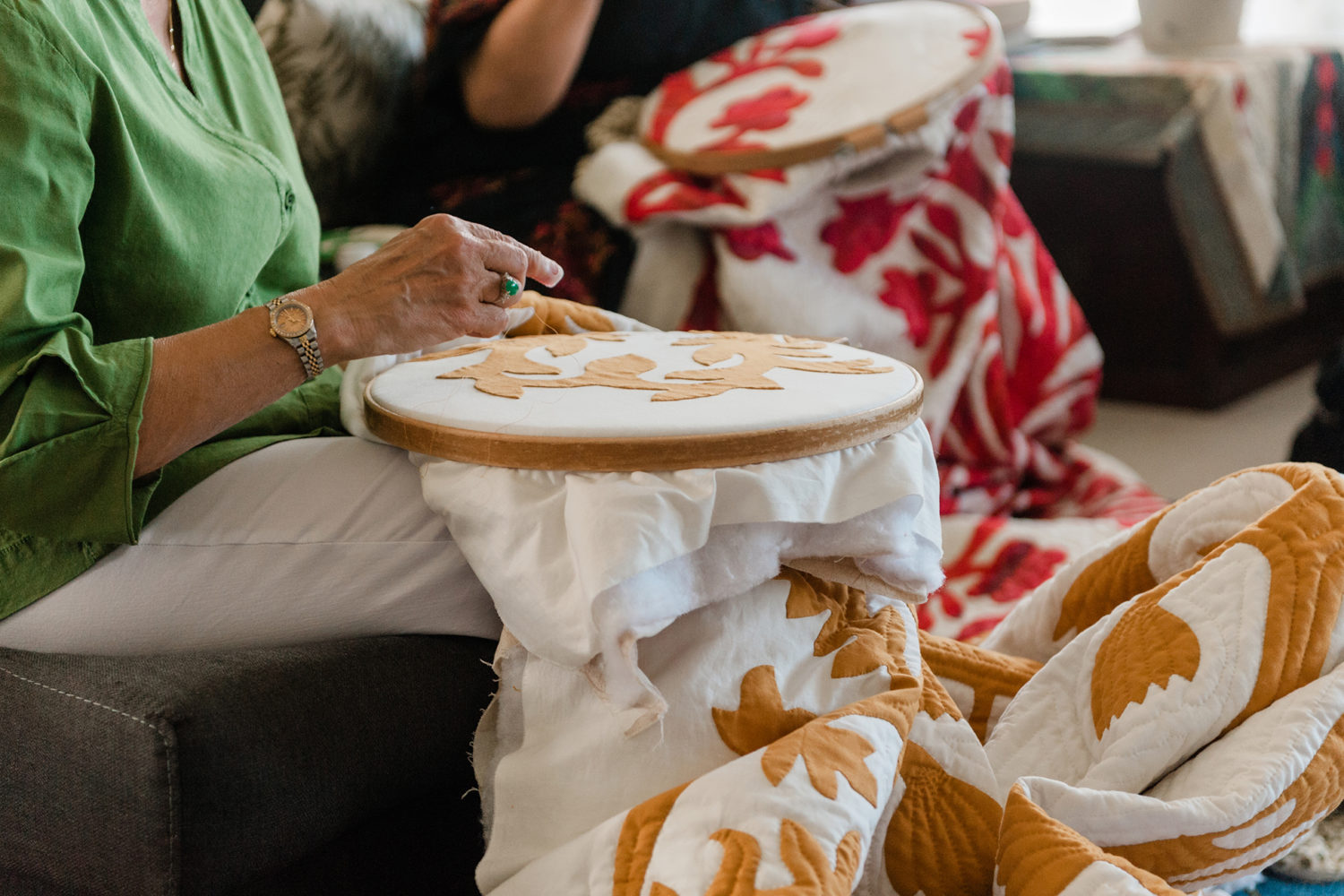

After some internet sleuthing, she found the original quilts and their makers. She later posted an Instagram story with screenshots of her research. As social media comments piled up on their original image, posted on June 5, Sea New York started turning off comments and blocking individuals like Naone. On June 10, Sea New York issued a statement that fell short of an apology.
“We never claimed these techniques as our own or intended to appropriate a culture and are sorry if some believe that to be the case,” read part of the statement, which was added to the caption of the original June 5 image.
They decided to donate an undisclosed amount to the organization Mana Maoli, a Hawai‘i nonprofit organization with a public charter school in Honolulu.
On June 12, Sea New York posted a carousel, saying, “It has come to our attention that the Sea quilting group has caused a great deal of anger and hurt amongst members of the indigenous people of Hawai‘i.”
This time, they clearly apologized: “We take responsibility and we are deeply sorry for the pain that we’ve caused.” They acknowledged that the “patterns used in these styles can most closely be attributed to the work of Hannah Ku‘umililani Cummings Baker and Rebecca Mahoe Haalou Medeiros,” but then wrote “The original quilt and iterations of the original work have been made by other native Hawaiian quilters,” which—when read cynically—almost sounds like a justification for their use of the print.
After all, if native Hawaiians also quilted it, why couldn’t they? Only Sea New York was profiting from the use of the patterns.
They’re not just picking up the design and stealing, they’re trading on people’s mana.
Linda B. Arthur
In response to an interview request for this story, Sea New York shared the following statement through a representative: “We discovered the beauty and distinct vibrancy of Hawaiian quilting through quilts sold at vintage shows and online.
We donated to Mana Maoli because we appreciate their mission and engagement with education. We have spoken with others in Hawaii and they have requested that Sea not publicize the discussions. We understand and respect those requests and will move forward privately.” As of September 2021, all pieces are still for sale on Sea New York’s website; they range from $395 to $600.
Whereas REDValentino had slightly altered Akina’s pattern, Sea New York’s were virtually carbon copies of the originals—bringing up the question of when appropriation is simply plagiarisation.
Still where there’s conflict, there’s opportunity for ho‘oponopono, the Hawaiian practice of reconciliation. REDValentino exemplified how an apology can and should be handled. “Usually with these big companies, the best-case scenario is they take everything down as if it never happened and not acknowledge it, but Valentino really wanted to acknowledge the wrong done,” said Olan Leimomi Fisher, a public policy advocate at OHA.
The recent appropriation of the Hawaiian quilt reinvigorated conversations around the craft and its history, emphasizing its importance in Hawaiian culture.
So, what is a pono way for continental and foreign designers to use Hawaiian quilting in fashion? As an example, Laitila mentioned Bode, the New York-based menswear brand which has arguably singlehandedly created the demand for quilted clothing: Their Hawaiian Quilt Jacket was derivative but not an exact replica. (As with all of its pieces, Bode also included background on the quilting design and its origins.)
Loewe, the Spanish luxury house helmed by creative director Jonathan Anderson, contacted quilters from the Poakalani quilting circle to show original textiles at the brand’s annual showcase at Salone del Mobile in Milan in 2019.
One of the members, master quilter Patricia Gorelangton, displayed four quilts—three previously made and one specially commissioned that featured a koi fish design by John Serrao, the founder of Poakalani and a master patternmaker. Some smaller wall hangings were purchased then cut and turned into purses, “which was like a knife to my heart,” said Gorelangton. “But it turned out they looked pretty neat.”
If anything, the recent appropriation of the Hawaiian quilt reinvigorated conversations around the craft and its history, emphasizing its importance in Hawaiian culture. “We could say it’s almost a national symbol,” said Laitila because the large applique style doesn’t exist anywhere else.
Yet its survival requires a new generation to carry it on. As master quilter Gorelantan said of the Hawaiian quilt, “I do hope that the younger generation will become as obsessed as some of us older people with the artform, with the ability to make something with their hands, and want to put the time involved into making something beautiful.”

